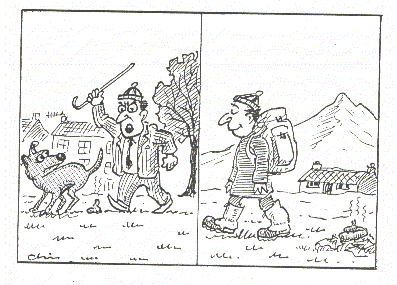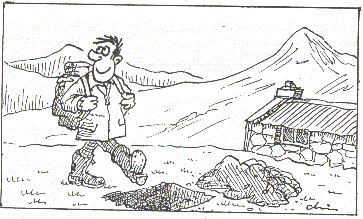Wilderness Sanitation
A Guide for Climbers & Hillwalkers
This article is reproduced from a leafted published by the Mountain Bothies Association. © Copyright and thanks to the MBA. The drawings are by Chris Tyler (© 1995,2002) and are reproduced with permission - thanks, Chris.
When we are in the hills we might like to think that we follow the old adage of "taking nothing but photo's and leaving nothing but footprints", but all of us are at some time guilty of leaving another sign of our passing. An unpleasant sign, which can totally ruin an idyllic wilderness spot for those who follow. Even though we are far from civilisation we must all, sooner or later, succumb to the call of nature.
In Nepal, the popular trekking route to Everest Base Camp is known as the Kleenex Trail. In some parts of the United States backpackers are obliged to carry all waste out with them. In Britain we make a great deal of fuss about dogs defacating in our parks and streets and yet as soon as we leave the towns and cities we are seemingly quite happy to perform our own toilet in such a way that those who follow can clearly see where we have been. This problem is particularly acute around bothies and at the foot of some popular crags. It is not just unpleasant to look at but can also present a very real health risk.

All drawings ©Chris Tyler 1995,2002
In 1994 th eMountain Bothies Association realised that something would have to be done, otherwise some much loved bothies might have to be closed down. This leaflet, produced in conjunction with Scottish Natural Heritage, is intentded to provide simple, basic, common-sense instructions which all who go into the hills should be aware of - for their own good as well as others. Please take note of them for all our sakes...
Carry a Trowel
Many DIY stores sell cheap, light-weight plastic trowels. One of these shoule be considered as part of your standard equipment; as essential as a stove and a sleeping bag. The extra weight (which need only be a few ounces) is more than offset by the knowledge that it enables you to dig a small toilet hole anywhere.
The "Cat Scrape"
Cats are very particular and clean creatures, especially with regards to their toilet practices. With the small trowel you now carry it is easy to copy the cat and dig a small scrape for your toilet.
Choose a secluded spot, well away from any water supply or path: the mimimum distance from any fresh water should be at least 15m, ideally much more.Don't choose a spot where someone might afterwards choose to camp or stop for a picnic. The best spot is often amongst some trees where the soil is softer and richer.
Dig out a small scrape in the ground. Thi scan easily be done with your boot (or ice axe) if you're not carrying your trowel. (Most bothies now also have a spade provided for this purpose.) It need not be deep - just a couple of inches is usually quite sufficient.
Only burn used toilet paper if it is absolutely safe to do so. Ideally it should be placed in a plastic bag and disposed of later in the bothy fire or public toilet. Toilet paper does not readily decompose, especially in cold, wet climates. however it is better to bury it than to risk starting a fire. Alternatively, many outdoor equipment retailers sell biodegradable toilet paper - which is of course ideal.
Cover the spot with soil, leaf litter and any other vegetation which may be at hand. This helps break down the faeces more quickly. Faeces actually decomposes quickest if left exposed to the air, however, as this is rather unpleasant for anyone else it should only be done if you can be absolutely certain that noone is going to pass that way for several weeks.
Group use Latrine
If a group of you are staying in one place for several nights it may be easier to dig a proper latrine pit.
- Choosing a location for the latrine pit
Basically, use common sense. The pit should not be too near to the bothy or campsite, but at the same time it shouldn't be too far off so that people won't use it. it should also be at the very least 15m from any fresh water - preferably further. Consideration should also be given to shelter - especially if the weather is likely to be wet. A good spot would be amongst treet as there will not only be more shelter, but more mico-organisms in the soil to aid decomposition. There should not be any problem with smels, although in very dry, windy weather it's probably best to choose a down-wind sport. Also, avoid any spot which future users might choose to camp on.
- Digging the pit
The pit need not be all that deep and should not reach down to the water table. (If water starts seeping in as soon as the pit has been dug then it is too deep.) An ideal depth for a temporary pit is about 30-50cm. The other dimensions will depend on the number of people using the pit but it should typically be about 30cm wide and 1m long.
- Preparing the pit for use
Before the pit is used place a layer of dead grass, bracken, leaves or similar vegetation in it. This helps absorb water and, as it decays, will help accelerate the decomposition of the faeces.
- Using the pit
Each time the pit is used, a scattering of dry soil, or better still ashes, should be sprinkled over the faeces (if possible a bucket of ashes should be kept nearby for this purpose). It should notmally be safe to burn use toilet paper in the pit, but if in doubt place it in a plastic bag and take it back to the bothy for burning on the fire there.
The pit should not be used for urination. The pit needs to be kept dry to ensure rapid decomposition, however, organic waste (uncooked fruit & veg) can be deposited in the pit.
- Closing the pit
Don't forget to fill the pit in before leaving the bothy or campsite! Fill the pit with more dead vegetation and ashes, then cover it with soil.

All drawings © Chris Tyler 1995,2002
Now Wash Your Hands!
Biodegradable soap is available which can be used directly in running water. Otherwise, collect water from the stream in your billy-can or other receptacle and use that as a wash basin. Empty the water away from the stream. Although amounts are small, washing with ordinary soap in a mountain stream contaminates the water and should therefore be avoided. Wet moss can be used if there is no nearby water supply.
It has been noted that:
Biodegradable soap does break down faster than other soaps,
but it is still toxic to aquatic life before that process is complete,
and therefor it is still good to use the soap away from the water
source.
It is reccommended that people use the soap 200 yards away from the
water and dump the soapy water into the vegetation. This will allow
time to work on the soap before it hits the water.
In Brief:
- Always carry a trowel.
- Dig a small hole and bury your excrement.
- Burn toilet paper if there is absolutely no risk of starting a fire. If there is a fire risk, pack it out or bury it.
- Never miss an opportunity to use a proper toilet!
- Never use normal soap in/near fresh water.

